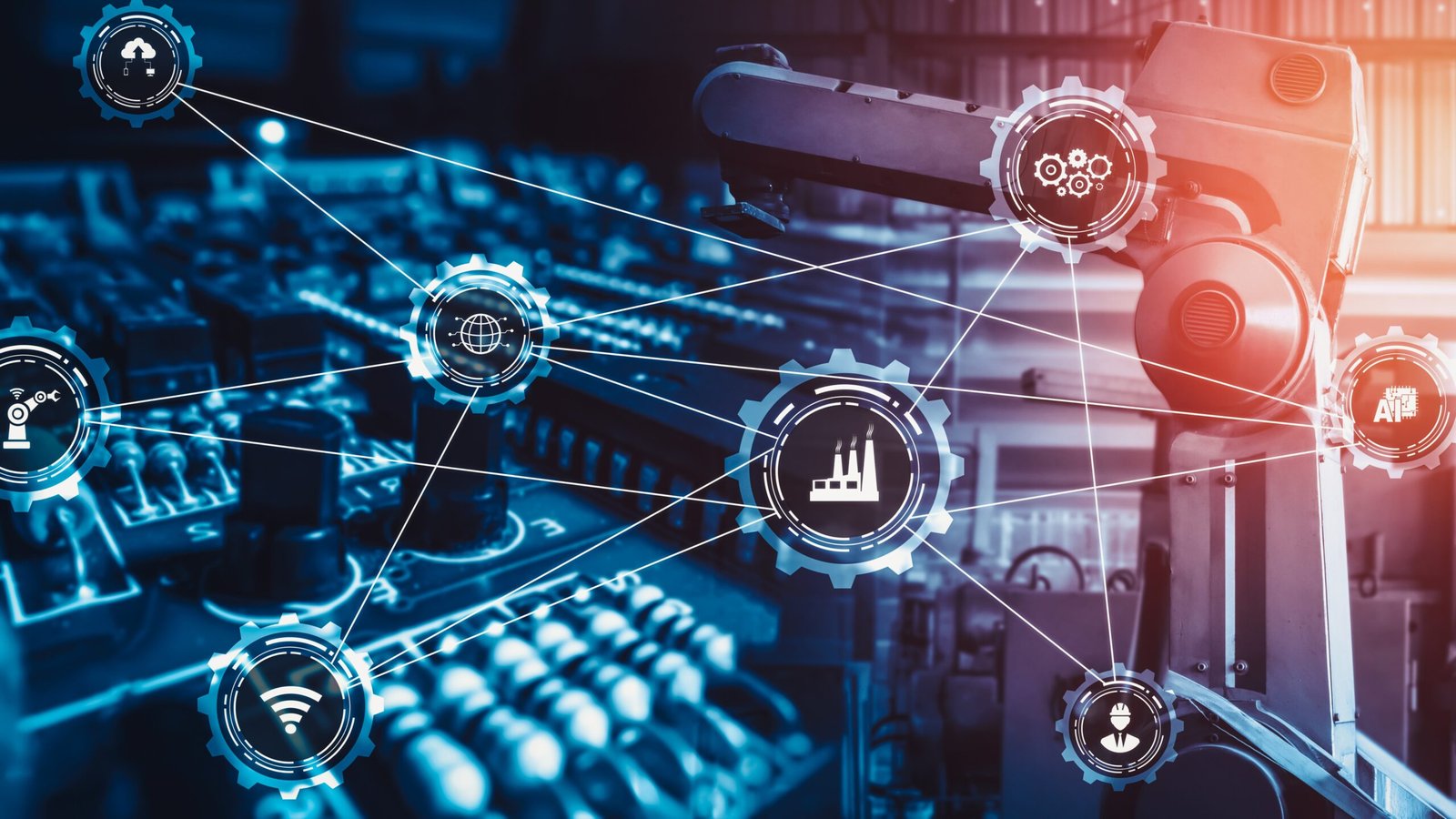Introduction – Reindustrialization : between persistent obstacles and levers of hope
During recent hearings at the National Assembly, Nicolas Dufourcq, CEO of Bpifrance, and Olivier Andriès, CEO of Safran, made a blunt observation: reindustrialization in France remains hampered by numerous obstacles. Administrative red tape, high tax pressure, recent political instability… The reasons for concern are numerous and very real.
Despite these obstacles, there are still reasons for hope. Among them, technological innovation stands out as a major lever, becoming essential to support industrial renewal, particularly through the transformation of factories toward a Manufacturing 4.0 production model.
From then on, an essential question arises: how can this transformation be made a reality, and what technological foundation can we rely on to be competitive, innovate, and produce better?
This is the objective of this article.
We suggest you revisit two essential elements :
- The technologies you need to know to switch to Manufacturing 4.0 mode, with a clear and educational approach,
- The IT infrastructure to be put in place to effectively integrate these technologies.
It is not enough to add technological tools: you also need to have an infrastructure capable of supporting and leveraging them.
To do this, we will focus on a critical technology, still too little known, but absolutely essential to successfully complete this transition: Edge Computing.

Part 1 – Operational efficiency : Where and how to act?
Improving a factory’s operational efficiency isn’t a vague concept.
It involves taking action on specific, concrete areas directly linked to the field.
Here are the six major levers that every industrial leader must look at as a priority :
1. Preserve and optimize the industrial tool
Every unplanned machine downtime is costly.
Preventive and even predictive maintenance, based on the analysis of data collected in real time (temperature, vibration, pressure, etc.), makes it possible to anticipate failures before they halt production.
2. Control energy consumption
With rising energy prices, tracking and optimizing consumption on a machine-by-machine basis is becoming a major economic challenge.
Energy monitoring allows for immediate detection of deviations and optimization of usage.
3. Guarantee product quality
Immediate detection of production defects drastically reduces reject rates, avoids costly recalls, and increases customer satisfaction.
Machine vision systems coupled with AI make this possible today.
4. Optimize logistics and inventory management
Too much inventory ties up cash. Too little inventory can paralyze production.
Connecting logistics flows to the workshop allows for real-time optimization of supplies.
5. Accelerate decision-making on the ground
Giving production teams immediate access to the right indicators allows them to act more quickly in the event of an incident, quality deviation or energy drift.
6. Strengthen traceability and compliance
In regulated sectors, ensuring detailed traceability of operations isn’t a choice : it’s an obligation.
Digital solutions make it possible to automate this traceability and secure audits.
All these issues have one thing in common : they require collecting, processing and exploiting production data in real time, directly in the field.
So the question is simple: What technologies can help us make progress on these six topics?
Part 2 – Technologies serving industrial performance
Once the right efficiency levers have been identified, the question is simple:
What technologies can address them in a concrete and measurable way?
The offering is vast, but each solution addresses a very specific use case.
Here is a clear summary of the main industrial use cases, associated technologies, leading suppliers, and examples of field implementations.
Industrial Use Cases | Key Technology(ies) | Suppliers (Solutions) | Concrete examples |
Predictive Maintenance | Industrial IoT, Real-Time AI | Siemens (MindSphere), IBM (Maximo), PTC (ThingWorx), GE Digital (Predix) | Vibration analysis to prevent industrial pump failure |
Energy Optimization | IoT Sensors, Smart BMS, Energy AI | Schneider Electric (EcoStruxure Power), Siemens (Desigo CC), Honeywell (Building Management System) | Dynamic optimization of Air conditioning in a food processing plant |
Quality Control | Machine Vision, Embedded AI | Cognex (VisionPro), Keyence (CV-X), Sick (Inspector PIM60) | Automatic detection of micro-scratches on windshields |
Inventory Optimization | RFID, IoT Logistics, WMS | Zebra Technologies (RFID), SAP (EWM), Oracle (IoT Asset Monitoring) | Real-time geolocation of forklifts in a multi-Site warehouse |
Rapid Field Decision-Making | Connected MES, Real-Time Analytics | Rockwell Automation (FactoryTalk), GE Digital (Proficy), AVEVA (PI System) | Instant Alerting Tablet-based quality assurance in the event of production deviations |
Traceability & Compliance | Advanced MES, IoT tracking, Document Management | Siemens (Opcenter Execution), Dassault Systèmes (DELMIA), Sparta Systems (TrackWise) | Complete traceability of production steps for pharmaceutical GMP compliance |
All these solutions offer considerable benefits for industry.
However, is it really that easy to introduce these new technologies into factories?
Not really.
Because before even talking about applications, we need to ask ourselves a fundamental question.
Is our current infrastructure truly capable of supporting these solutions?
And that’s often where the problem lies.
Part 3 – Infrastructure : the invisible foundation of Manufacturing 4.0

The benefits of switching to Manufacturing 4.0 are well established.
But before attempting to integrate AI tools, smart sensors, or advanced monitoring systems, we must ask ourselves a simple but crucial question :
Can yesterday’s and today’s infrastructure support tomorrow’s technologies ?
And unsurprisingly, the answer is no.
Why traditional IT infrastructure is no longer enough
In most industrial mid-sized companies, the current infrastructure is :
- Consisting of traditional servers installed in a computer room,
- Sized for administrative needs (ERP, messaging, files),
- Separated from the industrial operational network (OT).
This architecture was designed to :
- Manage office automation,
- Administrate the company,
- And sometimes monitor some local equipment.
But it was not designed to :
- Collect and process millions of data points per minute,
- React to field events in milliseconds,
- Ensure total resilience in the event of a network outage.
In short, the traditional infrastructure of industrial mid-sized companies wasn’t designed for real-time, resilience, or local autonomy. It’s currently hampering the practical implementation of the most promising technologies.
We therefore need to rethink infrastructure to enable factories to truly take technological leaps forward. The best-known solution to meet this need is the Cloud…
But in reality, is it really the preferred solution?
Part 4 – The Cloud : a major step forward, but not enough for the industry
Before we go any further, let’s just remind ourselves what the Cloud is : it’s a model where data, applications, and IT services are no longer managed locally on internal servers, but hosted remotely in vast data centers accessible via the Internet. This approach offers exceptional flexibility and allows access to powerful computing resources on demand.
The Cloud offers:
- Massive storage,
- Access to advanced analytics capabilities,
- Multi-site sharing.
However, several limitations make its exclusive use difficult to achieve Manufacturing 4.0 :
- Critical latency : In manufacturing, some decisions must be made in milliseconds. Sending data to a remote data center and waiting for a response is too slow to control a machine in real time.
- Internet dependency : In the event of a connection outage, a factory connected to the cloud can become blind. The disruption or degradation of industrial control can then generate enormous costs.
- Hidden costs : The constant transfer of massive volumes of data to the cloud results in high bandwidth and storage costs, which are often underestimated at the outset.
- Data sovereignty : Some industries (aeronautics, defense, pharmaceuticals) must ensure that their critical data remains under control. Using a public cloud exclusively can pose real legal and strategic risks.
In summary, while the Cloud offers undeniable advantages, its structural limitations make the direct implementation of Manufacturing 4.0 very difficult without adaptation: too slow for real-time control, too dependent on the network, potentially costly, and sometimes not compliant with the strategic requirements of manufacturers.
To overcome these limitations, another solution is emerging: Edge Computing.
But what exactly is it?
Part 5 – Understanding what Edge Computing is in practice
Today, many manufacturers hear about “Edge” without really knowing what it is.
It’s often presented as “a local cloud” or “AI in the factory.” This isn’t wrong, but it’s incomplete.
Here’s a simple but precise explanation.
What is the Edge physically ?
Concretely, industrial Edge Computing is :
- IT equipment (small servers, industrial boxes, micro-data centers),
- Installed directly in the factory, sometimes just a few meters from the production lines,
- And capable of collecting, processing and analyzing local data, without depending on the Internet or a remote Cloud.
This material is often reinforced: it resists heat, humidity, dust, vibrations.
It can be placed:
- In a technical cabinet,
- In the workshop,
- On a production line,
- Or embedded in a machine.
Edge is also intelligent software
An Edge server alone is just a piece of metal.
It’s what you install on it that makes the difference.
An Edge system includes :
- A lightweight operating system (often Linux or an industrial OS),
- Industrial connectors (to read data from automatons, sensors, PLCs, etc.),
- Analysis engines (business rules, algorithms, embedded AI),
- Local interfaces (dashboards, alerts, machine automation).
In summary, the Edge is a complete local platform that reads industrial data, understands it, processes it, and can act immediately (e.g., shut down a machine, trigger an alert, correct a parameter).
What the Edge can do, concretely
Here’s what a well-deployed Edge system in a factory can do :
Action | Examples |
Collect | Temperature, vibrations, noise level, speed, voltage, humidity, etc. |
Analyze locally | Anomalies, drifts, abnormal cycles, imminent failures |
Act immediately | Emergency stop, setpoint adjustment, visual or audible alert |
Filter | Eliminate unnecessary data before sending to the Cloud |
Continue operating | Even without an internet connection or active Cloud |
In summary, Edge Computing gives manufacturers the ability to accurately collect critical data, act instantly on incidents, ensure the continuity of their production without network dependency, and optimize the security and efficiency of their factory, while reducing the costs related to processing and massive data transfer, making it an essential tool for the operational efficiency of factories.
Edge Computing vs. Cloud Computing : The main differences
| Criteria | Edge Computing | Cloud Computing |
| Data location | Treated locally near the equipment | Centralized in remote data centers |
| Response time (latency) | Very weak (reactions in milliseconds) | Higher (depends on network and distance) |
| Resilience | Works even without an internet connection | Heavy reliance on network connectivity |
| Cost of data transfer | Reduced by local filtering | High due to massive data transfer |
| Security and sovereignty | Sensitive data stored on site | Risks associated with external data storage |
| Main use | Real-time response, operational continuity | Storage, massive analysis, strategic processing |
How is it different from traditional IT infrastructures?
Many mid-sized business owners already have servers in their companies.
But these aren’t Edge systems. Why?
Classic IT server | Industrial Edge System |
In an office or server room | On the factory floor, close to the machines |
Manages ERP, messaging, office automation | Manages production, sensors, and PLCs |
Not designed for real-time operations | Reacts in milliseconds |
Does not understand industrial data | Connected to PLCs, ready to interpret machine data |
Depends on a stable internal network | Resilient by design, autonomous |
Can we have multiple Edges in the same factory?
Yes, and it’s even a very good practice.
Each production island, or each critical machine, can be equipped :
- its own local Edge module (e.g., a ruggedized enclosure),
- connected to a primary Edge on site,
- which can itself synchronize useful data with the Cloud.
It is a star architecture, which allows :
- keep real time and resilience locally,
- while centralizing part of the data for global analysis.
Is Edge replacing Cloud?
No. It completes it.
The Cloud is very good for :
- store long-term history,
- centralize data from multiple sites,
- train complex models.
The Edge is essential for :
- react quickly,
- ensure local continuity,
- reduce network load.
It’s a complementary duo.
But in a factory, we often start with the Edge, because that’s where the gains are immediately visible.
Part 6 – Concrete cases of Edge deployment in French industry
Here are some concrete examples of Edge deployment in French industry.
🏭 Case #1 – A foundry
Initial problem:
- The ovens operate continuously at very high temperatures.
- Thermal monitoring was carried out by manual readings every 2 hours.
Solution deployed :
- Installation of thermal sensors + industrial Edge micro-servers,
- Local analysis of thermal distribution,
- Automatic adjustment of heating zones.
Results :
- 15% energy savings,
- 60% reduction in unplanned downtime.
🚗 Case #2 – Automotive equipment manufacturer
Initial problem:
- The welds were checked by post-production visual sampling.
- Non-conformities went unnoticed.
Solution deployed :
- Smart cameras + AI embedded on Edge boxes,
- Real-time analysis of each weld,
- Immediate reporting of defects.
Results :
- Scrap rate divided by 4,
- Annual savings estimated at several million euros.
Conclusion – The Edge is truly indispensable
In a context of economic pressure and global competition, innovation is no longer a choice, it is a condition of survival for French manufacturers.
Edge Computing, by bringing intelligence closer to production lines, makes it possible to act quickly, locally, and autonomously where performance is at stake on a daily basis.
But for these technologies to achieve their full value, it is still necessary to :
- ensure active technological monitoring, to identify the right levers,
- surround yourself with experts capable of making the link between IT and the workshop,
- and above all, structure a real IT/OT function, distinct from traditional management IT.
As with finance or quality functions, today we need an IT/OT manager who understands production and masters these new tools.
The connected factory is not just about smart machines.It also relies on informed technological choices, made by the right people, in the right place.
Towards a new industrial governance ?
Therefore, the real question for an industrialist becomes :
- Do we have the internal expertise today to master these issues ?
- Do we have a reference capable of effectively guiding us towards the adoption of these technologies ?
And if the answer is no, then another question naturally arises :
- Is it time to invest in technical talent with a strong OT dimension to build the industry of tomorrow ?
Given the context, this last question seems less and less rhetorical.
About the author

Ismail has 15 years of experience in IT and digital consulting. He spent nearly 7 years at Gartner. He has supported innovative startups in their growth strategy and worked with CIOs of large groups on their digital transformation. In 2021, Ismail founded Hubadviser to help CIOs challenge their vision with top-level experts.

